Refining Lubrication Practices
How the Sinclair Refinery Developed an Award-Winning Lubrication Program
By Jomathan McNees, Sinclair Wyoming Refining Co.
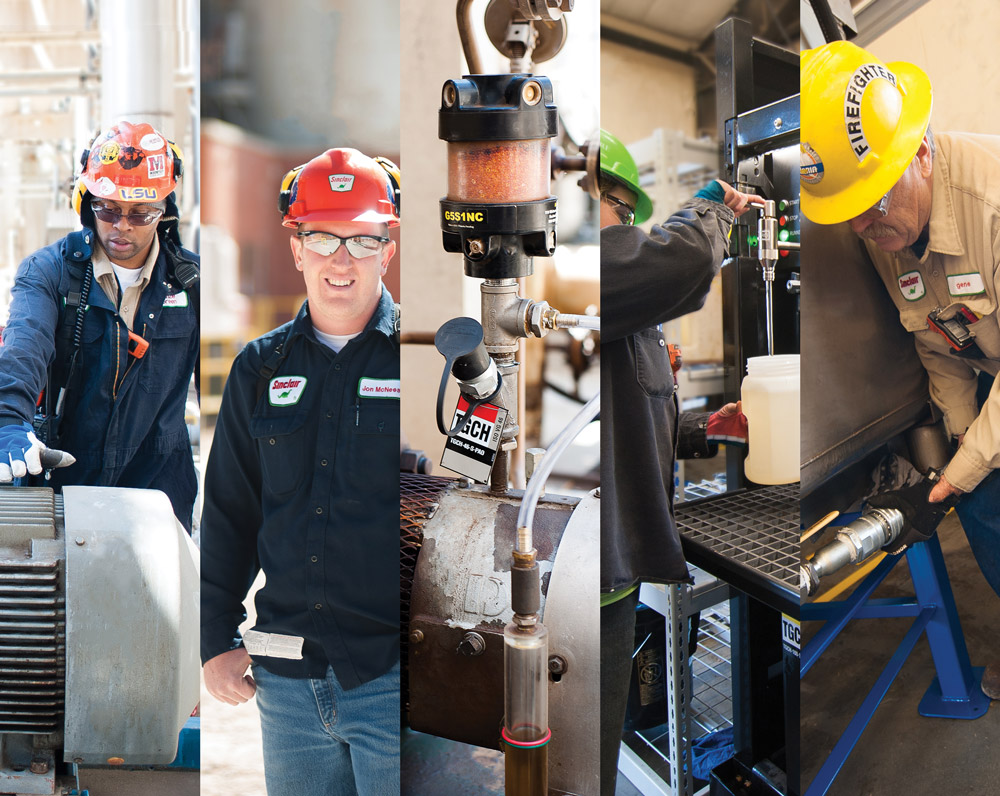
A little more than a year ago, the Sinclair Wyoming Refining Co. recognized the need to change its current lubrication practices in order to remain profitable and maintain its position as an industry leader. The task seemed daunting at first, but with guidance from Noria Corporation, great strides have been made in a short amount of time. The refinery is now approaching world-class status.
One of the first hurdles Sinclair faced was ensuring the proper lubricant was being applied to each specific component of a machine. Prior to implementing program changes, the refinery had experienced catastrophic failures of machines due to cross-contamination of grease and oils. By evaluating each machine and its lubricant requirements, Sinclair is more able to provide the exact lubricant for each lube point.
Sinclair Wyoming Refinery
Location: South-central Wyoming in the town of Sinclair
Year Started: 1923
Size: One of the largest high-conversion refineries in the Rocky Mountain region
Crude Processing Capabilities: In excess of 80,000 barrels per day
Awards: Received the 2013 John R. Battle Award for excellence in the application of machinery lubrication from the International Council for Machinery Lubrication and the 2005 Gold Award for achievement in safety from the National Petrochemical and Refiners Association.
The refinery also began to carefully review its current lubricants, looking for areas of overlap or for one or more lubricants with the same performance characteristics. This consolidation effort reduced the facility’s inventory from 34 total lubricants to 19. Not only did this help mitigate the risk of cross-contamination, but it also improved the quality of lubricants in storage by reducing storage time.
Now if the need for a new lubricant arises, equipment specifications are checked against all lubricants on hand. Lubricants are designated to ISO 6743 in order to quickly classify the oil type and additive package. By matching these ISO classifications, Sinclair is able to maintain its consolidation efforts, and the total number of lubricants can be kept as low as possible.
Among its future plans, the Sinclair team intends to procure a new field-services lubricant truck to maximize the efficiency of its lube staff.
Lubrication Program Design
In designing a new lubrication program and developing thousands of new procedures, the refinery had to determine the types of tasks that would be performed for each machine type onsite. To avoid the one-size-fits-all approach of maintaining equipment, Sinclair looked at a matrix of machine criticality, lubricant volume and environmental severity to systematically decide which machines should be included in its oil analysis program (predictive maintenance) and which ones should be maintained in more of a preventive manner.
Every machine deemed critical enough to be included in the oil analysis program had to be reviewed to ensure that samples could be taken from the correct zone. To do this, the refinery had to retrofit sample valves into each system so the maximum data density could be achieved, thus providing a consistent best-practice sample location. For some machines, this involved the addition of a valve on existing piping. For others, it meant installing a valve with a rigid tube assembly to allow the tube to be bent into the turbulent area of the oil. Oil analysis data from these sample valves is used in tandem with vibration data to ensure as many predictive tools as possible are utilized to draw conclusions about the equipment’s life cycle.

Some predictive maintenance methods are still performed on machines not included in the oil analysis program to obtain feedback on equipment health. For example, vibration analysis is used on some greased components that cannot be readily sampled for wear debris. In addition, the vast majority of equipment has external sight glasses and bottom sediment and water bowls to allow for visual oil inspections. These predictive visual inspections are completed by operators with reports of the findings triggering actions by the lube team or mechanics, based on the severity of the issue discovered.
Every piece of equipment in the facility benefits from proactive maintenance strategies. Prior to any oil being placed into service, it is tested to ensure it meets performance criteria as well as cleanliness and moisture target levels. Countless studies have shown that cleaner oil leads to longer machine life, and Sinclair has taken this to heart with its current practices. Decontaminating incoming oil and outfitting machines with upgraded contamination control accessories provide the machines with everything needed to operate at peak efficiency while running more reliably. Other proactive practices deployed at Sinclair include laser alignment, balancing and optimal lubricant selection.
Preventive maintenance (PM) is used to round out the rest of the program. Some examples of these tasks include periodic oil changes based upon equipment runtime and the routine regreasing of bearings and motors. Most of the machines being maintained with preventive methods are less critical and contain less lubricant. Therefore, it is more cost effective to change the lubricant than to analyze the current state of the lubricant and the machine to guide the schedule of events.
As the refinery’s machines continue to age and new machines are installed, Sinclair updates its records and procedures to ensure each machine receives proper maintenance. By continually reviewing its procedures and practices and staying current with the most up-to-date technology, the facility is poised to carry the lubrication program into the future.
Tracking the current status of the lubrication program is done on two fronts. Day-to-day operations, including sampling and installing tracking hardware, are performed using a spreadsheet developed by Noria. With this spreadsheet, the refinery is able to plot lubrication routes and look up individual tasks.
The facility is also in discussions to fully integrate its lubrication program database into a computerized maintenance management system (CMMS). Once the integration is completed, Sinclair will have the capability to track lube-tech work orders, route compliance, lubricant consolidation, lubricant consumption, lubricant costs and overall lubricant effectiveness.
Lubricant Storage and Handling
Lubricant storage and handling techniques, which previously had been a problem for the facility, have improved drastically in the past year. When new lubricants arrive onsite, they now are quarantined until deemed ready for service by oil analysis testing. This ensures the lubricants that reach the equipment meet the guidelines for cleanliness, performance and water content. This part of the handling program has expanded to include satellite lubricant storage, proper lubricant-dispensing equipment and the reduction of contaminant ingression during relubrication tasks.
In the past, lubricant handling had not been considered. Small oil containers were taken from the warehouse, filled with oil from whatever source was available and then left next to the machine and open to the environment until they were empty or oil was needed elsewhere. The same was true for grease guns. Storage was an afterthought, and most of these tools were found hanging from pipes or lying under equipment.
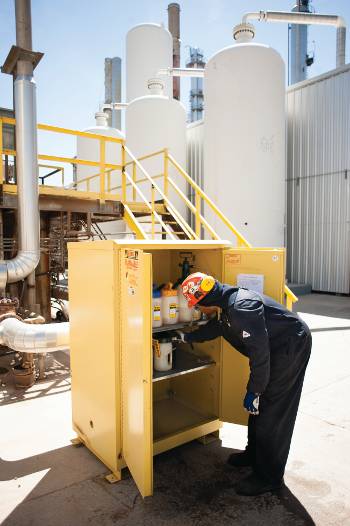 By educating its maintenance and operations personnel on the need for cleanliness and by purchasing weather-proof cabinets, the refinery was able to greatly improve its lubricant handling practices. Oil containers and grease guns are now stored in a clean cabinet that is sealed to keep out dirt and water. All equipment has also been labeled and color-coded to prevent cross-contamination.
By educating its maintenance and operations personnel on the need for cleanliness and by purchasing weather-proof cabinets, the refinery was able to greatly improve its lubricant handling practices. Oil containers and grease guns are now stored in a clean cabinet that is sealed to keep out dirt and water. All equipment has also been labeled and color-coded to prevent cross-contamination.
Bulk oil storage has been moved indoors with proper stock rotation principles observed. Previously, oil totes were staged across the refinery with no method or reason. Now oil comes to a central location before it is distributed throughout the plant. This enables better tracking of inventory levels and ensures that oil gets placed into service before its performance characteristics become impaired. These new practices have had a marked effect on equipment operation as well as the refinery staff. Personnel take better care of lubrication-related tools, and contamination is controlled more effectively.
Proper reclamation techniques are also in use at Sinclair. Small volumes of oil are captured in pails and then emptied into larger waste oil containers for disposal. For larger sumps and reservoirs, specially equipped vacuum trucks are utilized to pull oil into onboard reservoirs. This reduces the risk of high-volume leaks and permits large quantities of oil to be removed without workers ever having to touch the fluid with their bare skin. Plant personnel have been informed of the lubricant-related risks and have access to material safety data sheets in the event accidental contact occurs.
All lubrication PMs are housed in the CMMS system, which can be accessed by key personnel. The new detailed procedures have also been moved into this platform to allow access to everyone. Scheduling is based upon the calendar date as well as on-condition requirements. All lubrication tasks are documented and stored for review in case issues arise at a later date.
Monthly samples are taken from the critical machines and equipment recommended by Noria in its Lubrication Program Development. The results are reviewed by the maintenance engineer, and a failure report is created for each work order. Work orders are generated if the sample is deemed “condemned.”
Oil Analysis
Initially one of the strongest parts of its lubrication program, Sinclair’s oil analysis program is now even more robust. During the implementation stages of the new program, the refinery was able to add to its onsite laboratory equipment arsenal. The in-house lab can perform a wide array of screening tests for new oils and provide information on in-service oils. Onsite capabilities include testing for viscosity, elemental analysis, particle counts, water content, acid number and analytical ferrography.
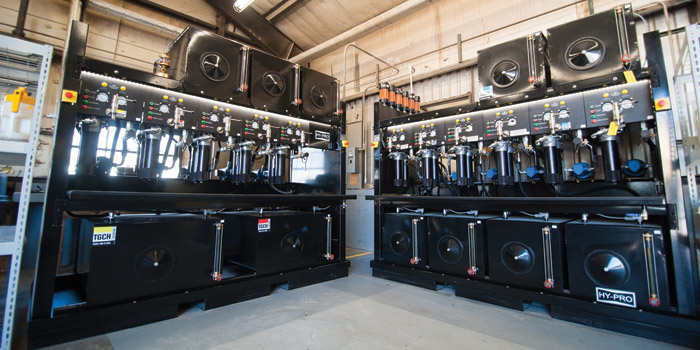
Laboratory personnel are trained on all lab equipment and can accommodate urgent samples with quicker turnaround times than shipping a sample to an offsite lab. Since the lab currently is unable to handle all samples, Polaris Laboratories is employed for exception testing and less critical applications. By using both onsite and offsite labs, Sinclair is able to check both labs for accuracy and ensure the results mirror each other.
All machines and oils do not undergo the same array of tests. Each oil and machine has its own customized test slate and target levels for contamination and moisture. The test slate takes into consideration the contaminant severity and failure modes for each machine type. For instance, the target cleanliness level for the main gear oil is 17/15/12. However, the target for turbine oils is 15/13/10. This is due to gearboxes being able to handle higher amounts of contamination before excess wear is generated. The same methodology is used for routine oil analysis test slates for each machine type.
Similar to the test slates, the alarms and limits for the testing methods have also been customized. There are alarms and limits for all three sides of the oil analysis triangle: physical properties, contamination and wear debris. By monitoring all three factors, the refinery is able to ensure lubricant and machine health and that all contamination control devices are working properly.
Of course, the best lab equipment and testing strategies are wasted if you aren’t able to obtain a good, consistent sample. This is why Sinclair installed sample valves on all the equipment in its oil analysis program. These sample valves enable the refinery to take clean samples from turbulent zones within the machinery. Lube techs have been trained in the operation of these valves and the proper way to extract a sample from machinery. This has increased the value of the oil analysis data and allowed values to be trended much more easily.
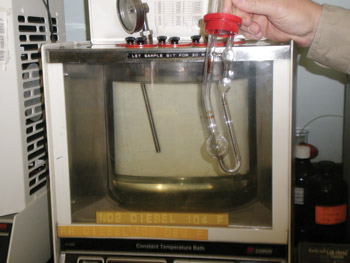 Each sampling tactic has its own detailed procedure that breaks down step by step how to attach the sampling device, flush the tubing and take the sample to ensure the maximum amount of data with the minimum amount of data disturbance from outside sources. These procedures are housed in the master lube program file and are provided in paper form to accompany lube techs during their sampling rounds.
Each sampling tactic has its own detailed procedure that breaks down step by step how to attach the sampling device, flush the tubing and take the sample to ensure the maximum amount of data with the minimum amount of data disturbance from outside sources. These procedures are housed in the master lube program file and are provided in paper form to accompany lube techs during their sampling rounds.
Sampling rounds are performed monthly on critical machines and quarterly on other equipment. If any alarms or limits are tripped on the test slate, secondary samples are obtained to confirm the results. Once the results are verified, action is taken to correct the issue. The correcting action can range from changing the oil to simply filtering the oil using a filter cart. Once an action has been taken, another sample is obtained to ensure the issue has been corrected.
Contamination Control
Contamination control at the refinery had been a weakness, but now contaminant ingression is in check. By modifying machines and training its personnel, Sinclair has greatly reduced the amount of contamination entering its lubricants through lubricant application or normal equipment operation.
Achieving a Culture Change
Education is a vital part of making lasting change in any organization. The Sinclair refinery identified this as a key area of focus early in its lubrication program development. The training it offers is based on an individual’s role within the program. Operators and mechanics are expected to complete half-day lubrication awareness training that outlines the fundamentals of lubrication, lubricant health, lubricant application and contamination control. These courses are provided in-house and based upon the shift schedule. Currently, 10 courses are offered with more planned in the future.
Lubrication technicians, laboratory personnel and engineers are required to attend a three-day seminar relating to their function in the program, such as oil analysis, lubricant application or machine-specific oil sampling. The lubrication program manager must complete advanced machinery lubrication and oil analysis courses. This advanced training is provided by Noria.
Certification through the International Council for Machinery Lubrication (ICML) is highly encouraged. The refinery also subscribes to magazines and newsletters to stay up to date on industry best practices and technologies.
This emphasis on education has helped the facility successfully achieve a culture change. Although changes initially were met with skepticism and opposition, by providing training and demonstrating the benefits of the new equipment, accessories and practices, this skepticism was eroded and opponents were won over for continued support of the program.
Operators and mechanics have learned the importance of contamination control and how they can affect a machine’s life by something as simple as leaving the breather plug off a machine during operation. The need for change was recognized and well-received. New devices have been implemented to aid in the exclusion of contaminants, including desiccant breathers, quick-connect fittings and external level gauges.
These devices work hand-in-hand with filter carts to decontaminate new oils being delivered as well as oils that are in use. The filter carts are designated for a single lubricant in order to reduce the risk of cross-contamination between dissimilar fluids. They also employ different size fittings on the cart’s inlet and outlet. This ensures lube techs hook up the cart correctly every time to avoid damaging the cart or machine due to backward oil flow. The same quick-connects are found on some top-up containers for adding small volumes of oil without opening up the equipment. This enables the refinery to have completely sealed equipment and still maintain it properly.
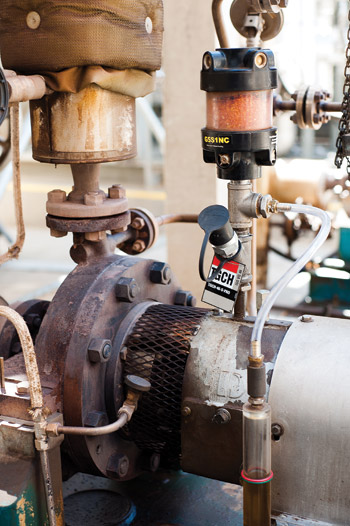 Filters in the filter carts are matched to target cleanliness goals as well as to the fluid type. Higher viscosity fluids utilize a 6-micron filter with a beta rating of 1,000. This guarantees that the maximum amount of particles is captured in a single pass. For lower viscosity fluids, a tandem filter setup is used consisting of a 6-micron beta-200 filter and a 3-micron beta-200 filter. The tandem filters permit oil polishing and cleaning down to the cleanest of targets.
Filters in the filter carts are matched to target cleanliness goals as well as to the fluid type. Higher viscosity fluids utilize a 6-micron filter with a beta rating of 1,000. This guarantees that the maximum amount of particles is captured in a single pass. For lower viscosity fluids, a tandem filter setup is used consisting of a 6-micron beta-200 filter and a 3-micron beta-200 filter. The tandem filters permit oil polishing and cleaning down to the cleanest of targets.
An ideal asset would include all the devices mentioned previously in order to service the machine without ever having to expose it to the atmosphere. This ensures the machine is operating to the best of its ability while reducing the amount of contaminants entering the system from the environment. To decrease the amount of wear debris produced in the machine, cleaner oil is delivered to the system, and the machine’s needs are matched to the oil’s performance characteristics. This results in the machine generating less wear and lasting much longer.
By utilizing sealable and refillable containers, the refinery is able to store small volumes of oil in satellite cabinets without the risk of them becoming contaminated. This further enhances the ability to provide clean oil to equipment. With these containers, operators and mechanics can top-up small volumes of oil without introducing large volumes of contaminants as they did previously. The containers are color-coded and labeled to match the equipment’s lube tags. Hoses attached to the pumps on the containers have reduced the facility’s dependency on funnels and have won over personnel with their ease of use and cleanliness.
Sinclair also replaced all of its grease guns. The old grease guns had varying output amounts, which made proper greasing difficult. The new color-coded grease guns have clear barrels, which allow the installed grease cartridge to be seen. The refinery also standardized on a single grease gun type to accurately dispense the proper volume of grease to bearings and electric motors. Understanding how much grease volume per stroke is being applied has reduced overgreasing issues, and bearings now run at a lower temperature.
Automatic lubricant-dispensing systems are now utilized as well. Currently, four processing units employ oil-mist systems on pump and turbine bearings. The mist systems are the preferred oil application systems because they are low maintenance and provide longer bearing life than traditional oil baths. As the refinery continues to improve its lubrication processes, it will look to further expand the use of these mist systems.
In applications that are hard to reach or where manual greasing could potentially cause bodily harm, the facility uses automatic grease applicators. These systems are set to dispense the calculated volume of grease required by the bearings and are monitored to ensure they are working properly.
Training Personnel
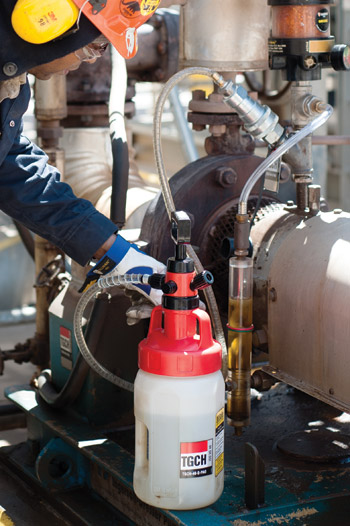 As new hardware was deployed at the refinery, training individuals who would be using these devices became increasingly important. By hosting lubrication awareness training onsite, Sinclair was able to instruct all personnel on the function and maintenance of oil and grease application systems. This training has proven invaluable.
As new hardware was deployed at the refinery, training individuals who would be using these devices became increasingly important. By hosting lubrication awareness training onsite, Sinclair was able to instruct all personnel on the function and maintenance of oil and grease application systems. This training has proven invaluable.
To avoid slipping back into mediocrity, the facility developed a plan for continuous improvement of its lubrication program. Training is an ongoing task to ensure all workers in the plant stay current with their understanding of lubrication fundamentals and techniques. Key members of the lubrication program further their education with advanced lubrication and oil analysis courses as well as advanced lubrication certifications.
The refinery soon realized a need for more lube techs and began to fill these roles to reduce the demand on operations and maintenance for lubrication-related tasks. It is also exploring the possibility of more laboratory personnel to enhance the capabilities of the in-house lab and to eliminate shipping samples offsite.
Future Plans
With the current lube storage building filling up with equipment, a new facility is being planned for lubricant storage. Sinclair also intends to procure a field-services lubricant truck to maximize the efficiency of its lube staff while maintaining strict cleanliness targets.
As it ventures into the future, the refinery is constantly looking for areas of improvement within its own processes and through new technologies. By being vigilant with its lubrication practices, the plant not only will become more profitable but also serve as a model for the rest of the refining industry.
